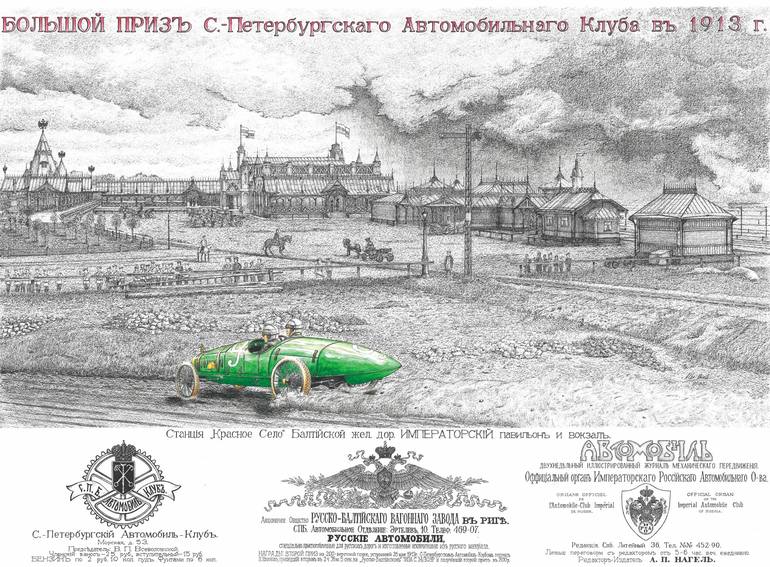





VIEW IN MY ROOM
About The Artwork
First Russian Race in a Circle road. Many details are hidden all over the drawing. My artworks are not copies of old photographs. Work on one picture usually takes up to 2 months. Many hours of research and reference material to make sure I rebuild the car and environment exactly the way it was in that race. In addition, all fonts, logos and advertisements were used in those years. 1913 ‘Russian Grand Prix’ near Saint Petersburg was held on 26 May, 1913, the official name was ‘First Russian Race in a Circle on a Distance of 200 versts’. It was organized by the St. Petersburg Automobile Club. Russo-Baltique Type C.24/30HP No.9 was painted green and earned the nickname ‘Russian Cucumber’ or ‘Racing Cucumber’, driven by Ivan Ivanovich Ivanoff finished second behind Suvorin on Benz. Ivanoff was fined 10 minutes penalty, posted the best lap time twice and showed an average speed of 126.1 km/h, but only finished second. As ‘Avtomobil’ magazine wrote then, the legal winner was Suvorin, and the actual winner was Ivanoff. The tires on the Russo-Baltique car were by the Prowodnik Factory. Architecture & Landscape: The railway station and the Imperial Pavilion in Krasnoye Selo. The station building was built in 1858-1859 by the architect Nikolai Lvovich Benois. The Imperial Pavilion was made in the Russian style, and the station building and wooden buildings were in the Gothic style. Unfortunately, all the buildings at the station were destroyed during WW2. Organisation & Advertising: - Russo-Baltique Russian advertising in 1913 - St. Petersburg Automobile Club logo in 1913 - Illustrated magazine of mechanical movement "Automobile" was the official press organ of the Imperial Automobile Society of Russia. The publisher and editor-in-chief was Andrei Platonovich Nagel, the most famous Russian motorist and journalist.
Details & Dimensions
Print:Giclee on Fine Art Paper
Size:9 W x 12 H x 0.1 D in
Size with Frame:14.25 W x 17.25 H x 1.2 D in
Frame:White
Ready to Hang:Yes
Packaging:Ships in a Box
Shipping & Returns
Delivery Time:Typically 5-7 business days for domestic shipments, 10-14 business days for international shipments.
Handling:Ships in a box. Art prints are packaged and shipped by our printing partner.
Ships From:Printing facility in California.
Have additional questions?
Please visit our help section or contact us.
Israel
I live and work in Beer Sheva, Israel. I am a self-taught artist, without professional art education. I started drawing cars when I was 2 years old, my mother carefully keeps my childhood drawings. And now, 40 years later, I'm still doing what I love. My graphic artworks are made in the technique of ink graphics with elements of watercolor, in the style of old engravings and old advertising brochures. My style is based on detailed drawing and historical accuracy. The artworks are mainly devoted to the history of world motoring, the first auto-sports competitions (since the 1900s), old architecture and Formula 1 racing. My artworks are not copies of old photographs. The first motor racing events took place over 100 years ago and there is very little information about it. Work on one picture usually takes up to 2 months. Many hours of research and reference material to make sure I rebuild the car and environment exactly the way it was in that race. I always strive to depict historically accurately all the things and details of the event. I research archival documents, old photographs, publications and articles in newspapers of those years, and much more, to be sure that all elements of the picture correspond to the historical period: architecture, landscape, weather, specification and color of cars, clothes of drivers, mechanics and spectators, advertising, and so on. In addition, all fonts, logos and advertisements that were used in those years. Only after careful preparation, I start drawing. It takes a lot of patience, diligence and passion to paint such detailed artwork. Drawing such small details requires high precision and concentration.
Thousands Of Five-Star Reviews
We deliver world-class customer service to all of our art buyers.
Global Selection
Explore an unparalleled artwork selection by artists from around the world.
Satisfaction Guaranteed
Our 14-day satisfaction guarantee allows you to buy with confidence.
Support An Artist With Every Purchase
We pay our artists more on every sale than other galleries.
Need More Help?